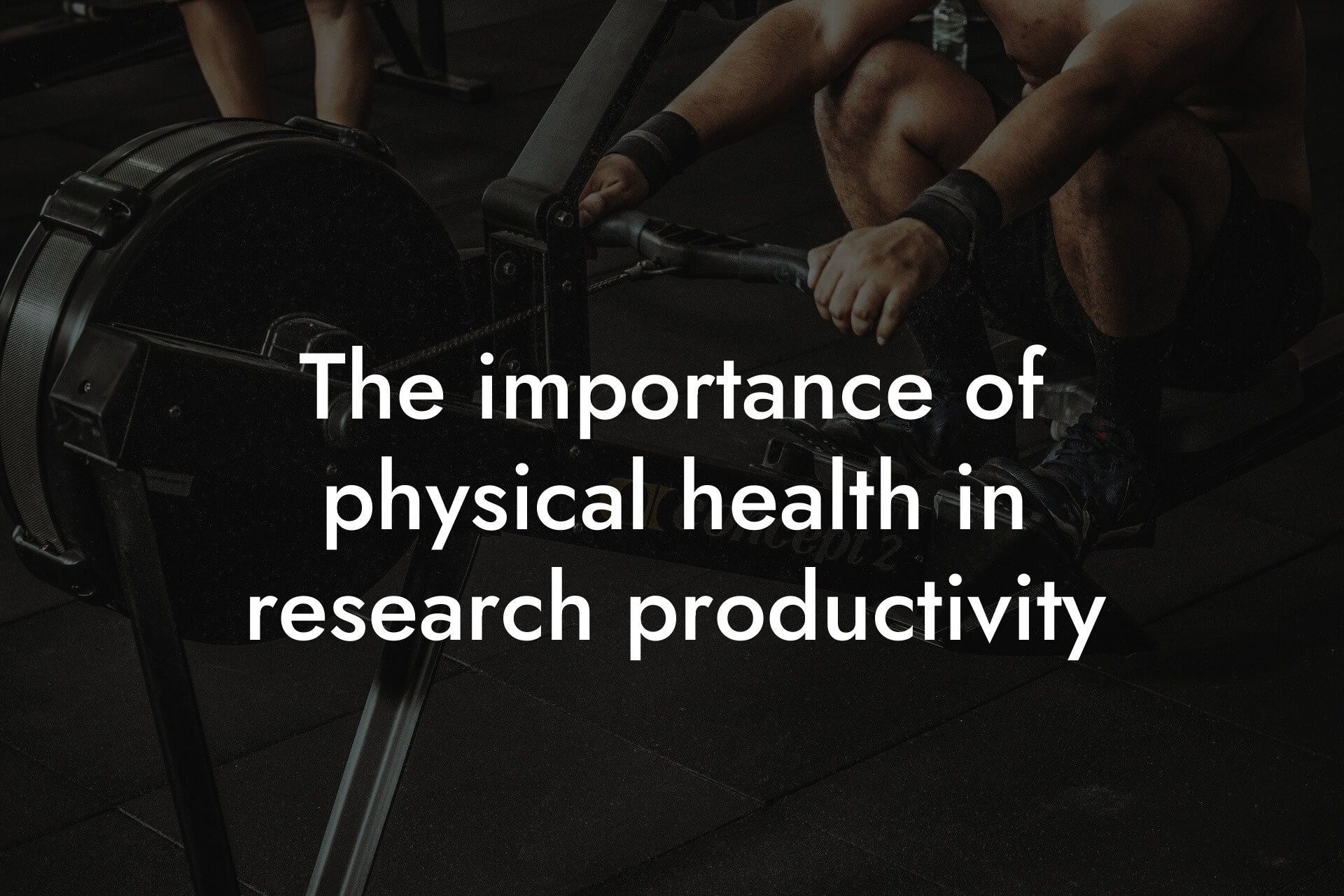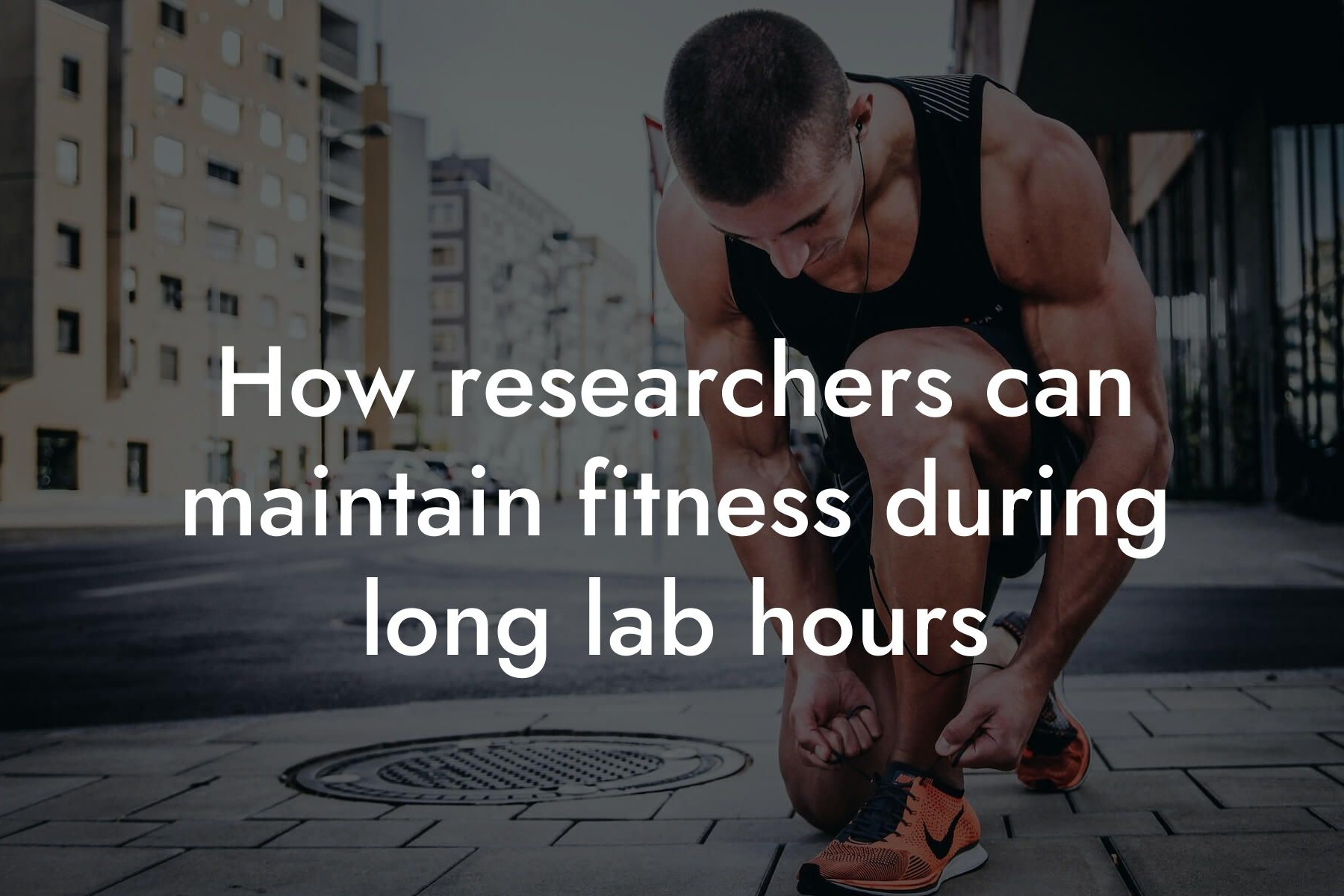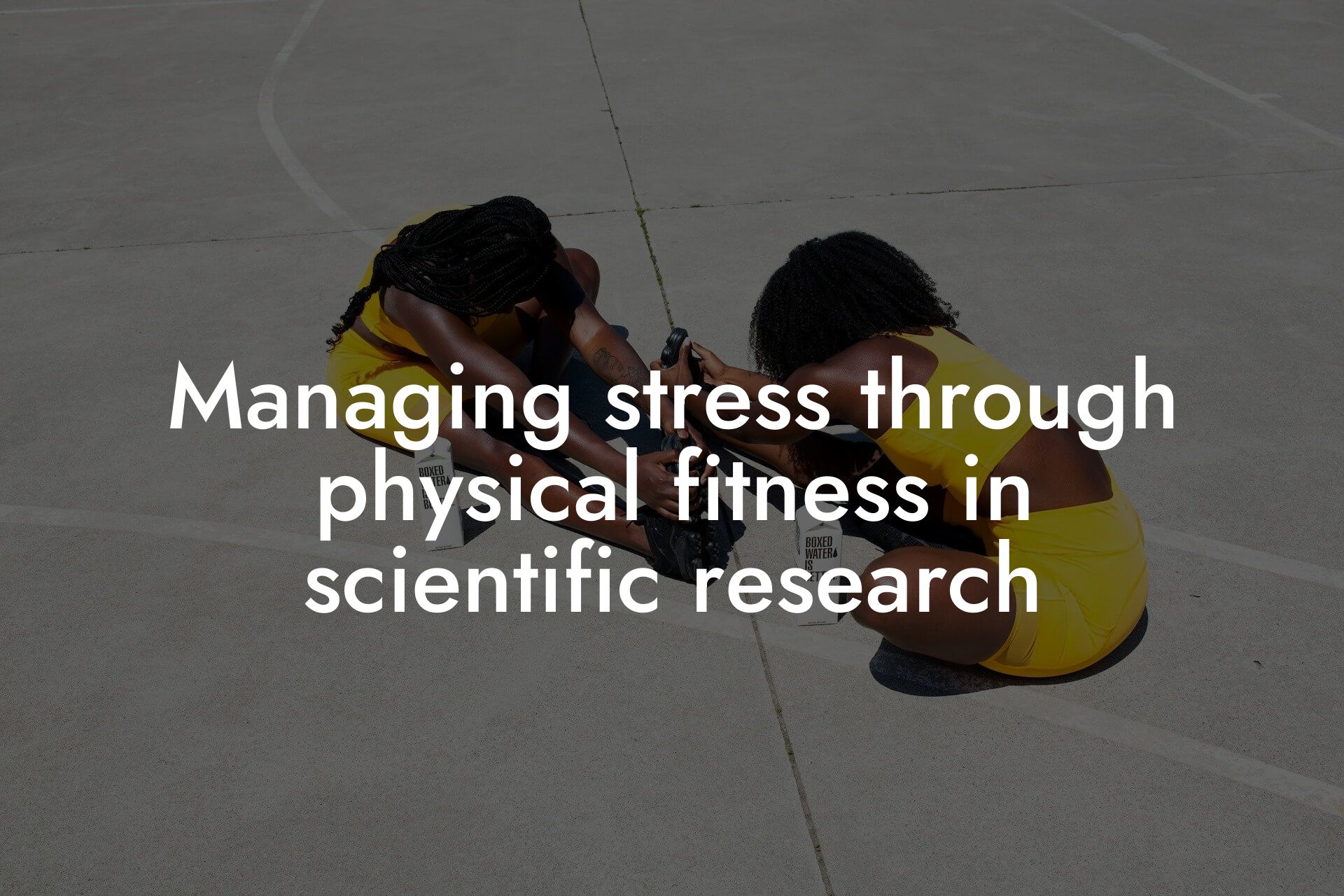As a high-earning professional, you understand the importance of maintaining a healthy and fit physique. However, did you know that physical fitness plays a crucial role in preventing research-related injuries? Whether you're a scientist, engineer, or academic, conducting research can be a physically demanding task that requires prolonged periods of sitting, standing, and repetitive movements. In this article, we'll explore the role of physical fitness in preventing research-related injuries and provide you with the information you need to take your research to the next level.
Table of Contents
The Risks of Research-Related Injuries
Research-related injuries can occur in various settings, including laboratories, fieldwork, and office environments. Some common injuries include musculoskeletal disorders, eye strain, and repetitive strain injuries. These injuries can result in chronic pain, decreased productivity, and even long-term disability. In fact, a study by the National Institute for Occupational Safety and Health (NIOSH) found that researchers are at a higher risk of developing musculoskeletal disorders due to prolonged periods of sitting and repetitive movements.
The Benefits of Physical Fitness in Research
Regular physical fitness can help prevent research-related injuries by improving flexibility, strength, and endurance. Physical fitness can also enhance cognitive function, reduce stress, and boost overall well-being. In a research setting, physical fitness can improve focus, concentration, and productivity, leading to better research outcomes. Additionally, physical fitness can reduce the risk of chronic diseases, such as heart disease and diabetes, which can impact research performance.
Types of Physical Fitness Exercises for Researchers
There are various types of physical fitness exercises that can benefit researchers, including:
- Cardiovascular exercises, such as jogging, cycling, or swimming, which improve cardiovascular health and reduce the risk of chronic diseases.
- Strength training exercises, such as weightlifting or resistance band exercises, which improve muscle strength and endurance.
- Flexibility exercises, such as yoga or stretching, which improve flexibility and reduce the risk of musculoskeletal disorders.
- High-intensity interval training (HIIT), which improves cardiovascular health and increases productivity.
Creating a Physical Fitness Routine for Researchers
Creating a physical fitness routine can be challenging, especially for busy researchers. However, with a few simple tips, you can incorporate physical fitness into your daily routine:
- Start small: Begin with short, 10-15 minute workouts, and gradually increase the duration and intensity.
- Schedule it: Treat physical fitness as a non-negotiable part of your daily routine, just like research or work.
- Find an exercise buddy: Having an exercise buddy can provide motivation and accountability.
- Mix it up: Vary your exercises to avoid boredom and prevent plateaus.
DEXA Scans and Physical Fitness
At Tano Performance Group, we understand the importance of physical fitness in preventing research-related injuries. That's why we offer DEXA scans, a comprehensive body assessment that provides detailed information on body composition, bone density, and muscle mass. Our DEXA scans can help researchers identify areas for improvement and track progress over time. By combining physical fitness exercises with DEXA scans, researchers can optimize their physical fitness and reduce the risk of research-related injuries.
Overcoming Barriers to Physical Fitness
Despite the benefits of physical fitness, many researchers face barriers to incorporating exercise into their daily routine. Some common barriers include:
- Lack of time: Researchers often have heavy workloads and tight deadlines, making it challenging to find time for exercise.
- Lack of motivation: Researchers may struggle to find motivation to exercise, especially if they're not seeing immediate results.
- Lack of access: Researchers may not have access to exercise facilities or equipment, making it difficult to incorporate physical fitness into their routine.
To overcome these barriers, researchers can try the following:
- Find exercises that can be done at home or in the office, such as bodyweight exercises or desk stretches.
- Find a workout buddy or accountability partner to provide motivation and support.
- Start small and set realistic goals, such as exercising for 10 minutes a day, three times a week.
In conclusion, physical fitness plays a critical role in preventing research-related injuries. By incorporating physical fitness exercises into their daily routine, researchers can improve flexibility, strength, and endurance, reduce the risk of chronic diseases, and enhance cognitive function. At Tano Performance Group, we're committed to helping researchers optimize their physical fitness and take their research to the next level. With our DEXA scans and comprehensive body assessments, researchers can gain a deeper understanding of their physical fitness and make data-driven decisions to improve their overall health and well-being.
Frequently Asked Questions
What is the primary goal of incorporating physical fitness into research-related activities?
Incorporating physical fitness into research-related activities aims to prevent injuries and improve overall well-being. By prioritizing physical fitness, researchers can enhance their physical resilience, reduce the risk of musculoskeletal disorders, and maintain their ability to perform at a high level.
How does physical fitness impact research productivity?
Physical fitness has a direct impact on research productivity. When researchers are physically fit, they can work for longer periods without fatigue, maintain focus, and experience improved mental clarity. This leads to increased productivity, better data quality, and enhanced research outcomes.
What are the most common research-related injuries, and how can physical fitness prevent them?
The most common research-related injuries include musculoskeletal disorders, back pain, and repetitive strain injuries. Physical fitness can prevent these injuries by improving posture, strengthening core muscles, and enhancing flexibility and mobility. Regular exercise also reduces the risk of falls and other accidents.
How can physical fitness improve mental health in researchers?
Physical fitness has a profound impact on mental health. Regular exercise reduces stress and anxiety, improves mood, and enhances sleep quality. This leads to improved focus, increased motivation, and better overall well-being. Physical fitness also reduces the risk of depression and other mental health disorders.
What are the benefits of incorporating physical fitness into a research schedule?
Incorporating physical fitness into a research schedule offers numerous benefits, including improved productivity, enhanced creativity, and better time management. Physical fitness also improves overall health, reduces absenteeism, and increases job satisfaction.
How can researchers balance physical fitness with demanding research schedules?
Researchers can balance physical fitness with demanding research schedules by incorporating short, frequent exercise sessions into their daily routine. This can include taking regular breaks to stretch, going for short walks, or engaging in high-intensity interval training. Scheduling exercise sessions into the daily planner can also help ensure consistency.
What are the best exercises for researchers to improve their physical fitness?
The best exercises for researchers include those that improve posture, strengthen core muscles, and enhance flexibility and mobility. Examples include yoga, Pilates, bodyweight exercises, and resistance band exercises. Cardiovascular exercises, such as jogging or cycling, can also be beneficial.
How often should researchers engage in physical fitness activities?
Researchers should aim to engage in physical fitness activities at least three to four times per week, with a minimum of 30 minutes per session. However, even small amounts of exercise, such as 10-15 minutes per day, can be beneficial.
Can physical fitness improve research quality?
Yes, physical fitness can improve research quality. When researchers are physically fit, they can maintain focus, think more clearly, and make better decisions. This leads to improved data quality, reduced errors, and enhanced research outcomes.
How does physical fitness impact research collaboration and teamwork?
Physical fitness can improve research collaboration and teamwork by enhancing communication, building trust, and promoting a positive team culture. When researchers are physically fit, they are more likely to be energized, motivated, and engaged, leading to better collaboration and teamwork.
What are the benefits of incorporating physical fitness into research team-building activities?
Incorporating physical fitness into research team-building activities offers numerous benefits, including improved communication, enhanced trust, and increased motivation. Physical fitness activities can also help reduce stress and improve overall well-being within the research team.
How can researchers measure the impact of physical fitness on their research performance?
Researchers can measure the impact of physical fitness on their research performance by tracking metrics such as productivity, data quality, and research outcomes. They can also monitor their physical fitness levels through regular assessments, such as fitness tests or body composition analyses.
What are the most common barriers to incorporating physical fitness into research activities?
The most common barriers to incorporating physical fitness into research activities include lack of time, limited access to exercise facilities, and perceived lack of relevance to research goals. However, with creative scheduling and a focus on short, frequent exercise sessions, researchers can overcome these barriers.
How can researchers overcome the perception that physical fitness is not relevant to research goals?
Researchers can overcome the perception that physical fitness is not relevant to research goals by educating themselves on the benefits of physical fitness for research performance and productivity. They can also share their experiences and successes with colleagues, promoting a culture of physical fitness within the research community.
What role does nutrition play in supporting physical fitness for researchers?
Nutrition plays a critical role in supporting physical fitness for researchers. A balanced diet that includes adequate protein, complex carbohydrates, and healthy fats can help fuel exercise sessions, support muscle growth and repair, and enhance overall health and well-being.
How can researchers prioritize physical fitness when working in a sedentary research environment?
Researchers can prioritize physical fitness when working in a sedentary research environment by taking regular breaks to stretch, going for short walks, or engaging in desk-based exercises. They can also consider using standing desks, exercise balls, or other ergonomic equipment to reduce sedentary behavior.
What are the benefits of incorporating physical fitness into research mentorship programs?
Incorporating physical fitness into research mentorship programs offers numerous benefits, including improved mentor-mentee relationships, enhanced research productivity, and better overall well-being. Physical fitness activities can also provide a unique opportunity for mentors and mentees to bond and build trust.
How can researchers make physical fitness a habit?
Researchers can make physical fitness a habit by scheduling exercise sessions into their daily planner, finding an exercise buddy or accountability partner, and tracking their progress. They can also celebrate small victories and rewards themselves for reaching physical fitness milestones.
What are the benefits of incorporating physical fitness into research conferences and workshops?
Incorporating physical fitness into research conferences and workshops offers numerous benefits, including improved attendee engagement, enhanced networking opportunities, and better overall well-being. Physical fitness activities can also provide a unique opportunity for attendees to bond and build relationships.
How can researchers prioritize physical fitness when working in a high-pressure research environment?
Researchers can prioritize physical fitness when working in a high-pressure research environment by incorporating short, frequent exercise sessions into their daily routine. They can also consider using stress-reducing techniques, such as meditation or deep breathing, to manage pressure and maintain focus.
What are the benefits of incorporating physical fitness into research training programs?
Incorporating physical fitness into research training programs offers numerous benefits, including improved research skills, enhanced productivity, and better overall well-being. Physical fitness activities can also provide a unique opportunity for trainees to develop important skills, such as time management and prioritization.
How can researchers make physical fitness a part of their research identity?
Researchers can make physical fitness a part of their research identity by incorporating physical fitness into their daily routine, sharing their experiences with colleagues, and promoting a culture of physical fitness within the research community. They can also consider incorporating physical fitness into their research goals and objectives.
Here are some related articles you might love...
- The importance of physical health in research productivity
- How researchers can maintain fitness during long lab hours
- Managing stress through physical fitness in scientific research
- The impact of body composition on cognitive function in research
- Quick workouts for researchers during lab breaks
- Balancing lab work with personal fitness goals
- Nutrition strategies for maintaining focus during experiments
- How to stay active during sedentary research work
- How DEXA scans can benefit scientists and researchers
Zak Faulkner
Zak Faulkner is a leading authority in the realm of physical health and body composition analysis, with over 15 years of experience helping professionals optimise their fitness and well-being. As one the experts behind Tano Performance Group, Zak has dedicated his career to providing in-depth, science-backed insights that empower clients to elevate their physical performance and overall health.
With extensive knowledge of DEXA technology, Zak specializes in delivering comprehensive body assessments that offer precise data on body fat, muscle mass, bone density, and overall physique. His expertise enables individuals to make informed decisions and achieve their fitness goals with accuracy and confidence. Zak’s approach is rooted in a deep understanding of human physiology, combined with a passion for helping clients unlock their full potential through personalised strategies.
Over the years, Zak has earned a reputation for his commitment to excellence, precision, and client-focused service. His guidance is trusted by top professionals who demand the best when it comes to their health. Whether advising on fitness programs, nutritional strategies, or long-term wellness plans, Zak Faulkner’s insights are a valuable resource for anyone serious about taking their health and fitness to the next level.
At Tano Performance Group, Zak continues to lead our Content Team revolutionising how professionals approach their physical health, offering unparalleled expertise that drives real results.




